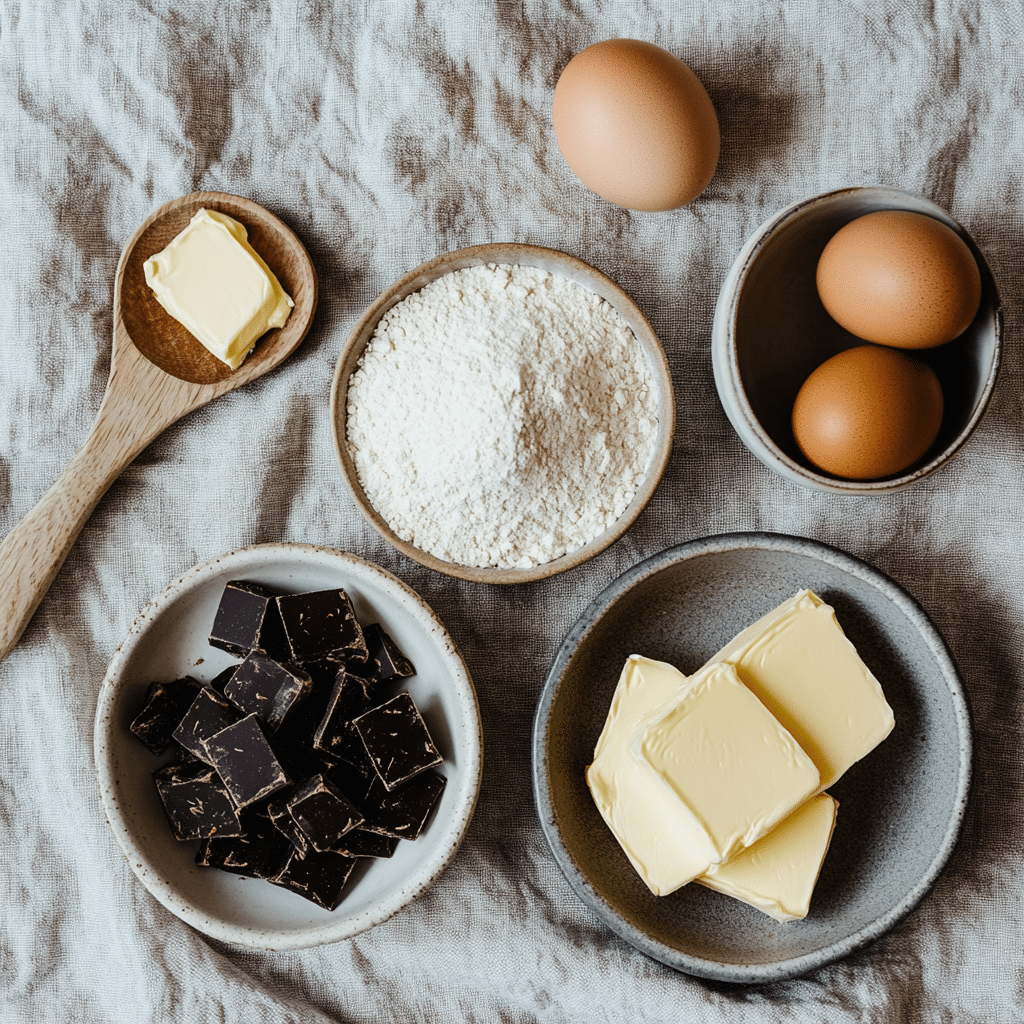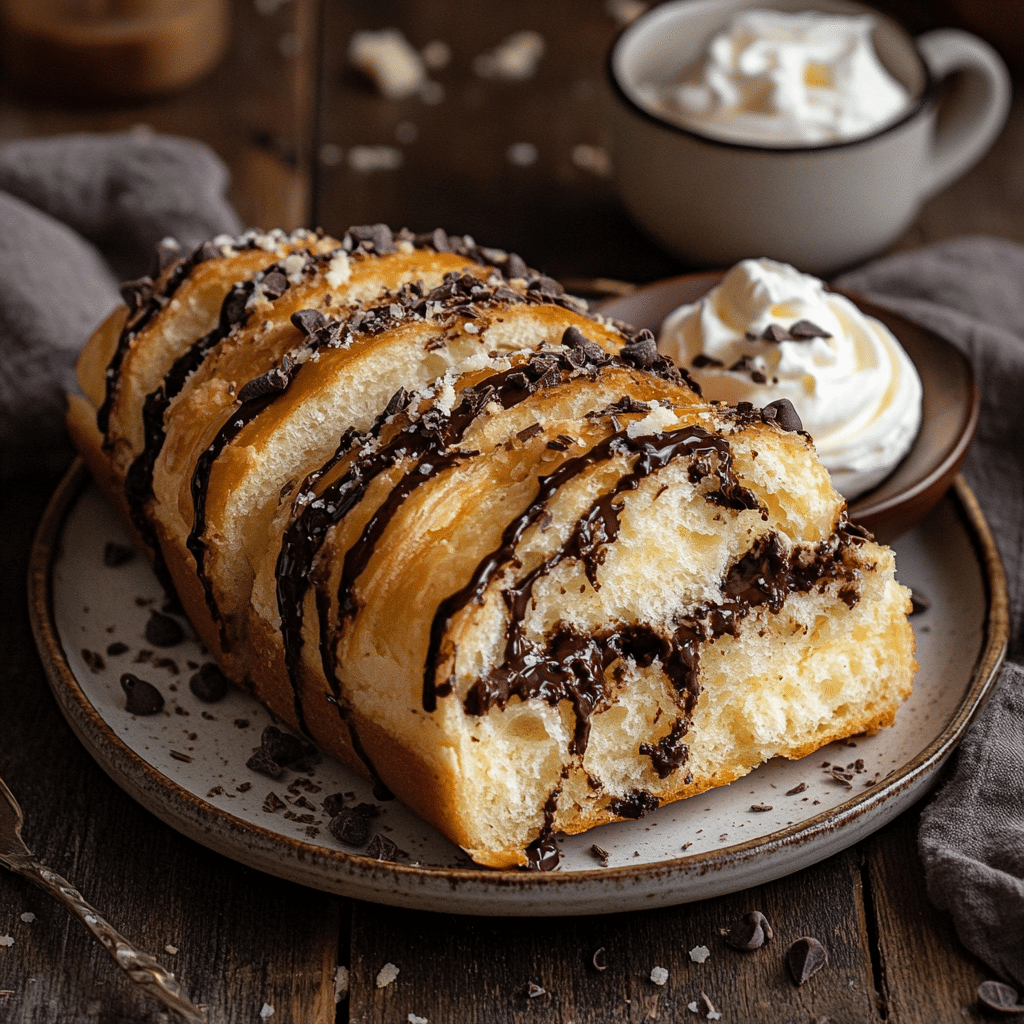Chocolate chip croissant sourdough bread is the kind of recipe that transforms your weekend bake into something unforgettable. Imagine the buttery flake of croissant layers, the tangy depth of wild sourdough, and ribbons of melted chocolate running through every bite. It’s rich, crisp, and indulgently tender—all in one loaf. Whether you’re a sourdough addict or just love a good pastry, this fusion bake hits every craving. In this article, I’ll guide you step-by-step through mixing, laminating, proofing, and baking, so you can create your own chocolate chip croissant sourdough bread that tastes like it came straight from a Parisian bakery.
Where Sourdough Meets Pastry Magic
The Accident That Started It All
Hi, I’m Marlene Quinn, and this chocolate chip croissant sourdough bread was born from one delicious mistake in my little Mendocino kitchen. Years ago, I had leftover croissant dough in the fridge, a bubbling sourdough starter (Clementine, of course), and a half-eaten bar of dark chocolate on the counter. My original plan? Croissants. What happened instead? I laminated the dough, rolled it into a loaf, stuffed it with chunks of chocolate, and baked it like sourdough. The smell alone had my teenage daughter sprinting from her room.
Since then, it’s become a weekend tradition at Marlene & Crumb. People come in asking, “Got that croissant bread today?” This recipe blends the best of both worlds—flaky pastry layers from croissant dough and depth of flavor from long-fermented sourdough.
Why This Combo Works So Well
Let’s talk flavor and texture. Sourdough starter lends a slightly tangy, complex depth that balances out the rich butter and sweet chocolate. Croissant dough brings those iconic flaky layers, thanks to a laminated structure. And the chocolate? It melts into little ribbons or pools, depending on your cut, adding intense richness.
This combo gives you a loaf with the crisp outer shell of artisan bread, the soft flake of pastry inside, and delightful bursts of chocolate. Plus, the fermentation makes it more digestible and gives it better keeping quality. Once you bake this, you’ll wonder why no one told you sooner.
Print
Chocolate Chip Croissant Sourdough Bread – 1 Flaky, Joyful Recipe You’ll Crave
- Total Time: 14 hours
- Yield: 1 large loaf 1x
- Diet: Vegetarian
Description
This chocolate chip croissant sourdough bread is buttery, flaky, tangy, and packed with dark chocolate—perfect for a weekend treat or holiday brunch.
Ingredients
400g bread flour
100g sourdough starter (100% hydration)
160g water
30g sugar
8g salt
2 eggs
280g unsalted butter (for lamination)
150g dark chocolate (chopped)
Instructions
1. Mix starter, water, sugar, flour, eggs, and salt into a sticky dough.
2. Bulk ferment for 4–6 hours at room temperature, folding every hour.
3. Chill dough for 30 minutes.
4. Laminate with cold butter using single folds, chilling between folds.
5. Roll dough into a rectangle and sprinkle with chopped chocolate.
6. Shape into a loaf or spiral and place in pan.
7. Cold-proof overnight in fridge (8–12 hours).
8. Bake at 425°F (220°C) with steam for 35–40 minutes.
9. Cool fully before slicing.
Notes
Use high-fat butter (82%+) for best lamination.
Dark chocolate over 60% cocoa gives a rich melt.
Let bread cool completely before slicing for best texture.
- Prep Time: 1 hour (plus overnight proof)
- Cook Time: 40 minutes
- Category: Bread, Sourdough
- Method: Baking
- Cuisine: French-American
Nutrition
- Serving Size: 1 slice (1/10 loaf)
- Calories: 350
- Sugar: 9g
- Sodium: 210mg
- Fat: 18g
- Saturated Fat: 11g
- Unsaturated Fat: 6g
- Trans Fat: 0g
- Carbohydrates: 39g
- Fiber: 2g
- Protein: 6g
- Cholesterol: 55mg
Keywords: chocolate chip croissant sourdough bread, sourdough croissant bread, chocolate sourdough
Building the Perfect Chocolate Chip Croissant Sourdough Bread
Ingredients That Matter Most
To make chocolate chip croissant sourdough bread that truly shines, the quality of your ingredients is everything. Start with an active, bubbly sourdough starter—it’s the soul of this bread. I always use Clementine, my well-fed, mildly tangy starter. You’ll also want a high-protein bread flour for structure, and plenty of cold, unsalted European-style butter for rich lamination. The butter should be at least 82% fat for smooth rolling and defined layers.
Then, the chocolate: avoid basic chips if you can. Choose chopped dark chocolate or couverture chocolate with at least 60% cocoa. It melts beautifully and balances the sourdough’s acidity. For a subtle boost, a pinch of sea salt and a touch of vanilla bring everything together.
Here’s a basic breakdown:| Ingredient | Purpose |
|---|---|
| Sourdough starter | Fermentation, flavor, rise |
| Bread flour | Gluten structure |
| Cold butter | Lamination, flakiness |
| Dark chocolate | Rich flavor bursts |

From Dough to Lamination
Once your dough is mixed and well-fermented, usually overnight, it’s time to laminate. Lamination sounds fancy, but it just means folding cold butter into the dough to create layers. Roll your dough into a rectangle, place your butter slab in the center, and perform a series of folds with chill time in between. Keep everything cold. This controls gluten development and preserves those crisp layers.
After the final fold, rest and chill your dough again, then gently roll it into a rectangle. Sprinkle chopped chocolate over the surface, fold or roll it up, and shape it into a loaf. Be careful not to tear the dough—you want those layers intact.
Proofing, Baking & Flavor Development
The Art of the Final Rise
Once your chocolate chip croissant sourdough bread is shaped, it needs one last rest—called the final proof. This step lets the dough relax and build flavor, but it’s also where home bakers often go wrong. Underproof it, and you’ll get dense layers. Overproof it, and the butter may leak or the structure collapse. What you want is the sweet spot: a jiggly dough that slowly springs back when gently pressed.
I proof mine overnight in the fridge. This cold fermentation gives it extra complexity, and the butter stays firm enough to hold its layers. Let it sit at room temp for about an hour before baking so the oven spring isn’t too aggressive. You’ll notice the dough becomes more puffy, not doubled, but softly alive. That’s your signal it’s ready to bake.
It turns out, a long cold proof not only improves flavor—it makes sourdough easier to digest.
Getting the Bake Just Right
Baking croissant-style sourdough isn’t quite like baking a regular loaf. You want to start hot—around 425°F (220°C)—with plenty of steam. If you have a Dutch oven, use it. Otherwise, toss a few ice cubes onto a hot baking tray placed at the bottom of your oven to mimic professional steam injection.
The steam helps the dough expand and creates that beautiful, glossy crust. Bake for 35 to 40 minutes, rotating halfway through. The bread should be deep golden brown, with chocolate peeking through the cracks. You’ll hear a faint crackle as it cools, and if you resist slicing into it while it’s molten, the layers will hold beautifully.
I experimented with this same technique while visiting friends in Alaska—it became the center of our weekend brunch up there.
This step is where the magic becomes visible: steam-lifted layers, chocolate striations, and a loaf that sounds hollow when tapped. Your kitchen will smell like a European bakery—and taste like one too.

Serving, Storing & Getting Creative
How to Serve It Like a Pro
When your chocolate chip croissant sourdough bread comes out of the oven, golden and fragrant, don’t rush it. Let it cool fully to allow the chocolate to set and the crumb to firm up. Slice with a serrated knife and serve warm to release the full aroma of butter and tangy sourdough.
This bread works beautifully as a stand-alone indulgence or the star of a weekend spread. I love it paired with whipped mascarpone and orange zest, but it’s equally stunning with raspberry compote or a smear of salted butter. If you’ve already enjoyed recipes like my sourdough low FODMAP 2, this elevated treat will feel like the next level in flavor and texture.
To get that bakery-worthy moment at home, slice your chocolate chip croissant sourdough bread thick and serve on a cutting board surrounded by berries and fresh mint. It’s the kind of loaf that belongs on brunch tables, potlucks, or a quiet morning with strong coffee.
Storage & Custom Variations
Good news—chocolate chip croissant sourdough bread stores surprisingly well. Wrap leftovers in parchment and keep them in an airtight container at room temperature for two days. After that, you can refrigerate or freeze individual slices. Reheat gently in the oven or toaster for warm, flaky results.
Want to make it your own? Add chopped hazelnuts, swap in white chocolate, or fold in espresso powder for a mocha twist. Even a swirl of cinnamon or a sprinkle of sea salt flakes before baking gives this chocolate chip croissant sourdough bread a fresh personality. The structure is strong enough to handle flavor variations while keeping its laminated integrity.
Inspiration abounds at Quick USA Recipe, where you’ll find dozens of ways to transform sourdough into something unexpected. Once you master this loaf, you’ll keep coming back to it—one variation at a time.

FAQs About Chocolate Chip Croissant Sourdough Bread
1. How do you make chocolate chip croissant sourdough bread?
You start by preparing a rich, sourdough-leavened dough using an active starter, similar to brioche or croissant base. Once the dough is mixed and bulk-fermented, it’s laminated with cold butter to create those signature flaky layers. After multiple folds and chill periods, dark chocolate is incorporated—either as chips or chopped chunks. The shaped loaf is cold-proofed overnight, then baked at high heat with steam for a crisp crust and delicate crumb. The result is a deeply flavorful hybrid between pastry and artisan bread.
2. Can you use sourdough discard in croissant dough?
Technically, yes—but for best results, it’s not ideal. Sourdough discard lacks the active yeast needed to properly ferment and lift a laminated dough. It can contribute flavor, but won’t give you the same rise or structure. If you want to use discard, combine it with a small amount of commercial yeast or active starter. For croissant-style bakes like chocolate chip croissant sourdough bread, full-strength starter ensures strong gluten development and that beautiful rise.
3. What kind of chocolate is best for croissant sourdough bread?
High-quality dark chocolate with at least 60% cocoa is best. Couverture chocolate melts into silky layers without burning or turning grainy. Avoid waxy chocolate chips—they contain stabilizers that resist melting. Instead, opt for chopped bars or discs. You can also experiment with milk chocolate, white chocolate, or even add inclusions like sea salt or espresso nibs for extra depth. The bold flavor of sourdough pairs especially well with bittersweet varieties.
4. How do you store chocolate chip sourdough croissant bread?
After baking, let the loaf cool completely. Store at room temperature in an airtight container for up to 48 hours. To extend freshness, wrap individual slices in parchment and freeze. When you’re ready to enjoy it again, warm slices in a toaster or oven until the edges are crisp and the chocolate softens. Avoid refrigerating unless absolutely necessary, as it can dry out the laminated structure faster.
Conclusion
Chocolate chip croissant sourdough bread is more than just a recipe—it’s a flaky, tangy, chocolate-filled journey worth savoring. This loaf brings together the bold character of sourdough and the indulgent elegance of croissant pastry in a way that feels both rustic and refined. With a caramelized crust, delicate crumb, and ribbons of melted chocolate, it’s a showstopper for any occasion.
From the mixing bowl to the final bake, every step of making this bread offers a chance to learn, create, and fall in love with sourdough all over again. If you’ve ever doubted whether croissant-style baking and sourdough could live in harmony, this bread is the proof—literally.
I hope this recipe becomes a regular part of your baking rotation. And if you’re like me, it may even inspire new ideas, flavors, and joyful mistakes along the way. When you try it, I’d love to see your results—tag us or comment through Quick USA Recipe. Here’s to mixing, layering, and baking something magical—slice by slice.

